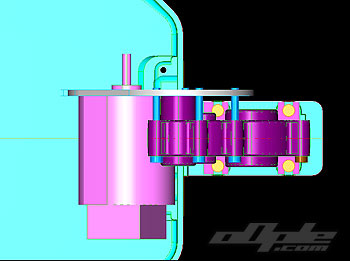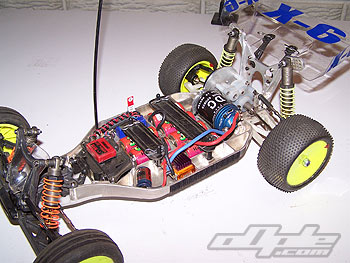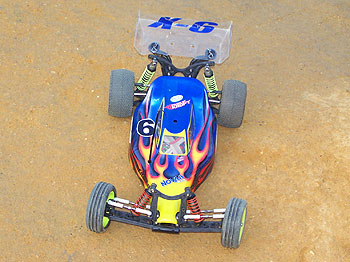 Here are some words from Chazz Sinclair of XFactory, on the X-6's development - from concept to reality. Here are some words from Chazz Sinclair of XFactory, on the X-6's development - from concept to reality.
Paul started racing 9 years ago with a xx-4, and by the time he completed
his third or fourth race weekend, Chazz and Paul were asking
themselves: "Why do the buggies have the motor in the back? Our xx-4
handles so much better, what would happen if we removed the front belt,
diff, drive shafts, etc. and ran it as a buggy?"
We never actually did it, and I think Paul forgot about it, but I never
did, and the "spark" happened right at the beginning. It wasn't a matter
of creating a car to go with the X - 5, but rather something we thought
about long before the X - 5. There were a number of reasons why the X - 5
had to be first, but essentially the X - 6 has been with us since the very
beginning.
Greg Hodapp put it best: "I've never seen a Ferrari with the motor hanging
out the back." In the US, with the major championships contested at "blue
groove" tracks like Hot Rod Hobbies, Scottsdale Raceway, ARCOR in
Albuquerque, and Lake Park in Florida, off-road more closely resembles
on-road with jumps.
 |
 |
When the rear-motor buggy was designed, US tracks were loose and sandy; so
the rear motor helped with weight transfer when the throttle was squeezed
to generate forward traction. At blue groove US tracks, and at many grass
and/or astro tracks in U.K., forward traction is not a problem, and we
think the weight distribution of The New Math is conducive to better
handling and better jumping on these high-traction surfaces.
The major change we made from the first prototypes was to move the motor
and batteries back about 9/32". We just had the weight too far forward,
and now it's moved as far back as possible.
One of the cool changes we made near the end was in the window masks. For
a number of reasons Paul wound up with two prototype bodies at the ROAR Mod
Nats, one with conventional windows and one wrap-around. I walked through
the pits with both bodies side by side and took a poll, which turned out 9
to 1 for the wrap around. So wrap around it is, although Jason left some
faint pillars in if you want to use them.
We have never considered anything other than molded parts -- chassis and
others. We've never seen a carbon fiber chassis that is, in our opinion,
stiff enough for off-road. In on-road, where the control arms and shocks
are short with stiff springs, they use chassis flex, essentially, as a
tuning aid. In off-road, where suspension travel must be greater, we want
the chassis totally stiff so the suspension is controlling the car. You
don't see a flexible Ferrari. |
 |
Magnesium machined chassis on this early prototype |
|
Even though The New Math is an off-road car, its weight distribution allows
a more on-road driving line. In the US, the rear motor guys have developed
the "point-and-shoot" driving style where the car is driven straight to the
apex, the brakes are slammed on, the car is "rotated" around the apex, and
then accelerated straight to the next corner. This is probably the fastest
way to drive that kind of car.
To go back to Hodapp;s comment, you don't see F-1 drivers using
"point-and-shoot. If that were the fast way around, they would do it. Our
goal was to design a car that would allow use of the "natural" racing line.
The nose piece was copied from Losi. We thought that most chassis breaks
would occur in that area, and this way a customer can simply replace the
nose. It costs only about a third, and takes only a few
minutes. Experience to date bears this theory out. The car has been out
for about three months, and we know of no customer who has broken a
standard chassis, but several have broken nose pieces. It actually costs
more to make the chassis in two pieces, because we must make two molds, but
we think it's worth it.
We began by machining two chassies from Delrin. The front section of both
main chassies broke, so # 3, which was machined from fiberglass-reinforced
Delrin, added much material here around the servo mounting area. (Too
much, it turns out.) #3 didn't break, so we machined #4 from magnesium and
#5 from aluminum. #4 is only an ounce or two heavier than the molded
graphite chassis, and we made #5 look like a piece of Swiss cheese for Paul
to drive. Poor Dan & Chris were drooling by then.
 |
Paul Sinclairs late prototype X-6 with early Jconcepts shell |
|
The motor and batteries were moved back 9/32" to their present position on
#4 & 5, and when they proved fast at the Cactus Classic and Losi race we
went forward with the mold.
Brian and Ellis have been the best imaginable additions to the
Team. That's the real truth, not P.R. Both are well known for design and
development work, and they have been contributing from day one. We
honestly don't know if Brian will ever race again -- we and he expect he
will -- but that does not matter. Both Brian and Ellis will have their own
line of parts sold through X Factory. The first two parts in the D.D.P.
line (Dirtz Dialed Partz) are actually in our hands now and we're working
on packaging and logo design. Ellis' first part is currently in
testing. More parts are in the design stage from both drivers, as well as
Chris.
|
Of course Ellis is a threat to win any race he enters and he's getting
comfortable with both cars. Check his results with the X - 5 on his first
drive at the inaugural CML race. Ellis was already interested in a
mid-motor buggy before joining X Factory, and the work he's doing with the
car is wonderful. E-mails fly back and forth daily between all Team
members on both sides of the Pond, and Paul, Brian, Chris, Dan, Ellis, and
now Frank all contribute. We're working on four or ive issues every day,
and our cars just get faster.
In fact, we think our development work went fairly smoothly. I didn't
mention anything about a major issue in the foregoing, and there really
weren't any. The final design is reasonably close to what we sketched out
in July of 2005 with Paul, Greg, and I sitting in a motel room. Of course
there will be hurdles to overcome in any design process -- that's what
makes it interesting and fun! In fact, I'd say that if it goes together
too smoothly there's something wrong somewhere you haven't found and you're
making a big mistake!
Jimmy: "Are there any optional parts coming for the X - 6 or other things
you are working on that you can tell us about?"
Chazz: "Yes, and no."
Jimmy: I'm with you - we'll wait and see! Thanks for all the help and great support you give the RC community chazz, and good luck in the future. |

